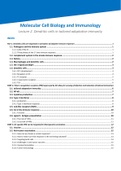Class notes
Lecture 2. Dendritic cells in tailored adaptative immunity (AM_470656)
- Course
- Institution
- Book
Lecture on dendritic cells, information on the role in the activation of the immune system, pattern recognition receptors and tailored immunity, and use in therapeutics and vaccines.
[Show more]




